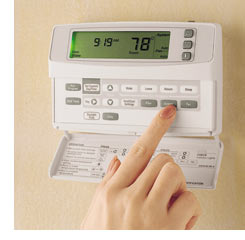Have you ever noticed that when it comes to heating, ventilation and cooling discussions, you feel like there is another language being spoken? As with most areas of specialty, this is the case! The following list of terms is a primer on the common terms bantered about by HVAC specialists.

Glossary of HVAC Terms
ACH
ACH stands for Air Changes per Hour. It is the number of times in one hour that the air in a house is completely replaced with outside air.
AFUE
The AFUE, or Annualized Fuel Utilization Efficiency, is the ratio of the total useful heat the gas furnace delivers to the house to the heat value of the fuel it consumes.
Btu
Btu, short for British Thermal Unit is a unit of heat energy. One Btu is the amount of heat needed to raise the temperature of one pound of water 1°F. To get a rough idea of how much heat energy this is, the heat given off by burning one wooden kitchen match is approximately one Btu.
Conduction
The transfer of heat through a solid material.
Convection
The transfer of heat by air flow.
COP
Coefficient of Performance, COP, is the ratio of energy input to heating capacity. This is the instantaneous measurement of the heating performance of the heat pump. It is comparable to knowing how many miles per gallon of gasoline a car gets when it is going full speed. You can find the COP on the nameplate of the heat pump.
EER
Energy Efficiency Ratio, EER, is the instantaneous measurement of the cooling efficiency of an air conditioner or heat pump. The higher the EER for an air conditioner or heat pump, the more efficient it is.
Heat Pump
A heat pump is basically an air conditioner with a reversible valve that allows it to operate in reverse, removing heat from the house and shunting it outdoors in the summer, and removing heat from outdoor air and shunting it into the house in the winter. Because heat pumps do not actually create heat—they just move it from one place to another—heat pumps are more efficient than other forms of heating.
HSPF
The Heating Seasonal Performance Factor, HSPF, is an efficiency rating for heat pumps. It is a measure of the average number of Btu of heat delivered for every Watt-hour of electricity used by the heat pump over the heating season. It takes into account variations due to weather conditions over a season. HSPF is comparable to knowing how many miles per gallon of gasoline a car got, averaged over the entire year.
Programmable Thermostat
A thermostat with the ability to record different temperature settings for different times for heating and/or cooling equipment. Programmable thermostats can be electronic, or mechanical.
Radiation
The transfer of heat directly from one surface to another (whithout the intermediate air acting as a transfer mechanism).
SEER
The Seasonal Energy Efficiency Ratio, SEER, measures the average cooling efficiency, over the entire cooling season for an air conditioner or heat pump.
System Capacity
System capacity is a measurement of the total amount of heat or cooling the furnace, heat pump or air conditioner can produce in one hour. This amount is reported in Btu/hr on the nameplate of the equipment.
(Source of Terminology: Home Energy Saver)

This is a great resource for building a new home. I know that part of your new home investment is your air system. When it comes to the terminology I was so lost, but this post really helped guide me.